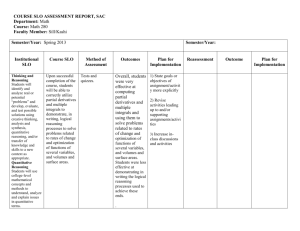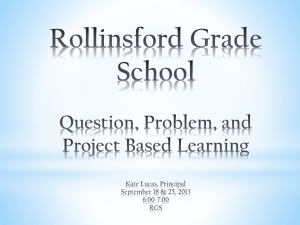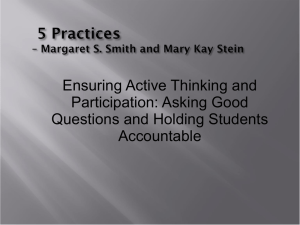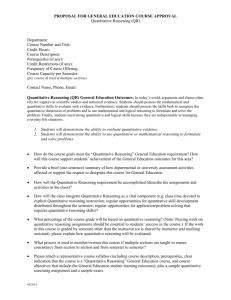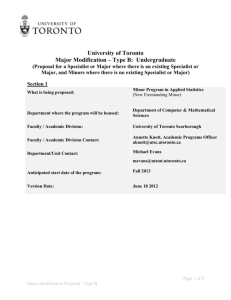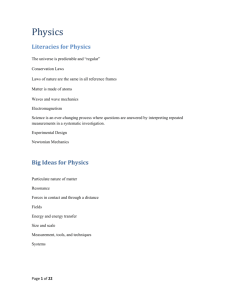(CEMS) Submission Preparation Template
advertisement
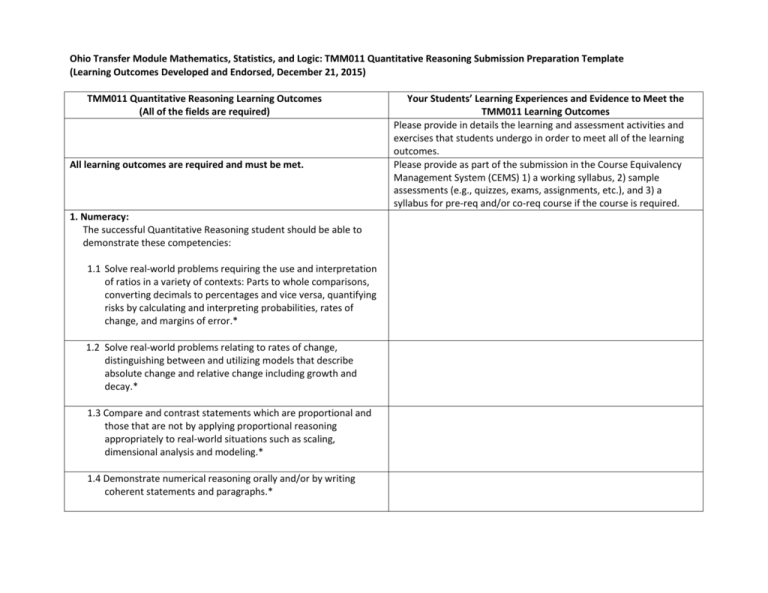
Ohio Transfer Module Mathematics, Statistics, and Logic: TMM011 Quantitative Reasoning Submission Preparation Template (Learning Outcomes Developed and Endorsed, December 21, 2015) TMM011 Quantitative Reasoning Learning Outcomes (All of the fields are required) All learning outcomes are required and must be met. 1. Numeracy: The successful Quantitative Reasoning student should be able to demonstrate these competencies: 1.1 Solve real-world problems requiring the use and interpretation of ratios in a variety of contexts: Parts to whole comparisons, converting decimals to percentages and vice versa, quantifying risks by calculating and interpreting probabilities, rates of change, and margins of error.* 1.2 Solve real-world problems relating to rates of change, distinguishing between and utilizing models that describe absolute change and relative change including growth and decay.* 1.3 Compare and contrast statements which are proportional and those that are not by applying proportional reasoning appropriately to real-world situations such as scaling, dimensional analysis and modeling.* 1.4 Demonstrate numerical reasoning orally and/or by writing coherent statements and paragraphs.* Your Students’ Learning Experiences and Evidence to Meet the TMM011 Learning Outcomes Please provide in details the learning and assessment activities and exercises that students undergo in order to meet all of the learning outcomes. Please provide as part of the submission in the Course Equivalency Management System (CEMS) 1) a working syllabus, 2) sample assessments (e.g., quizzes, exams, assignments, etc.), and 3) a syllabus for pre-req and/or co-req course if the course is required. 2. Mathematics Modeling: The successful Quantitative Reasoning student should be able to demonstrate these competencies: 2.1 Create and use tables, graphs, and equations to model realworld situations including: using variables to represent quantities or attributes, estimating solutions to real-world problems using equations with variables, identifying pattern behavior, identifying how changing parameters can affect results, and identifying limitations in proposed models.* 2.2 Model financial applications such as credit card debt, installment savings, loans, etc. and calculate income taxes.* 2.3 Create basic linear and exponential models for real-world problems and be able to choose which one is most appropriate for a given context and describe the limitations of the proposed models.* 2.4 Use basic logarithm properties to address questions (regarding time periods etc.) arising in real-world situations modeled exponentially.* 2.5 Explain and critique models orally and/or by writing coherent statements and paragraphs.* 3. Probability and Statistics: The successful Quantitative Reasoning student should be able to demonstrate these competencies: 3.1 Critically evaluate statistics being presented in the media, journals, and other publications including evaluating the research methodology, critiquing how the author(s) came to their conclusions, identifying sources of bias, and identifying Developed and Endorsed December 21, 2015 confounding variables. Students will be able to critically evaluate sampling strategy, the impact of sample size, correlation versus causation, and any inferences made.* 3.2 Summarize and interpret datasets with regard to shape, center, and spread. Use both graphical and numerical information. Use statistics appropriate to the shape. Students will be able to compare two or more datasets in light of this type of information.* 3.3 Create visual representations of real-world data sets such as charts, tables, and graphs and be able to describe their strengths, limitations, and deceptiveness.* 3.4 Calculate probabilities and conditional probabilities in realworld settings, and employ them to draw conclusions.* 3.5 Justify decisions based on basic statistical (probabilistic) modeling orally and/or by writing coherent statements and paragraphs.* Developed and Endorsed December 21, 2015

